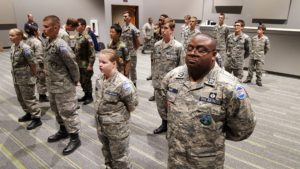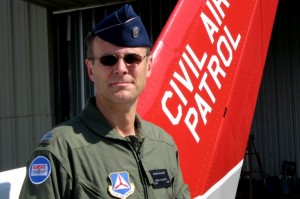Mission
By DanielHeartland Squadron members are CAP Volunteers In Action. Founded in 1941, the Civil Air Patrol is one of America’s largest civilian volunteer forces, numbering more than 60,000 members. CAP is the Official Auxiliary of the U.S. Air Force, and our mission includes providing Emergency Services, Cadet  Programs, and Aerospace Education to our communities. CAP’s 1500 local squadrons in 50 states operate 550 aircraft that fly over 100,000 hours per year. Heartland Squadron brings these capabilities to Kansas City.
Programs, and Aerospace Education to our communities. CAP’s 1500 local squadrons in 50 states operate 550 aircraft that fly over 100,000 hours per year. Heartland Squadron brings these capabilities to Kansas City.
Search & Rescue – Civil Air Patrol Emergency Services personnel perform 90% of the inland Search and Rescue missions in the U.S., saving an average of 75 lives each year. CAP assets include highly trained personnel, aircraft, vehicles, trained ground teams, and the largest emergency radio network in the U.S.
 Cadet Program – Heartland Cadet Squadron offers KC teens access to Civil Air Patrol’s Cadet Program–providing 25,000 American teens some of the finest leadership training and practical experience available. Heartland cadets demonstrate excellence by reaching the highest levels of the the CAP Cadet Program and serve as outstanding young leaders in our community.
Cadet Program – Heartland Cadet Squadron offers KC teens access to Civil Air Patrol’s Cadet Program–providing 25,000 American teens some of the finest leadership training and practical experience available. Heartland cadets demonstrate excellence by reaching the highest levels of the the CAP Cadet Program and serve as outstanding young leaders in our community.
Cadet Leadership Training – CAP Cadets at Heartland earn the privilege of wearing a distinctive Air Force Uniform, and work to earn promotions to advance in grade from Cadet Airman Basic, through the Cadet NCO ranks, into the Cadet Officer Corps, and into top Cadet leadership. Heartland Cadets who work hard will go far in CAP and well beyond!
 Aerospace Training – Heartland Squadron provides our Cadets and educators access to outstanding Aerospace Education resources—including flying in our CAP aircraft. Aerospace Education is a cornerstone of CAP Cadet Program, and learning opportunities abound, including outstanding Aerospace curricula and National Flight Academies.
Aerospace Training – Heartland Squadron provides our Cadets and educators access to outstanding Aerospace Education resources—including flying in our CAP aircraft. Aerospace Education is a cornerstone of CAP Cadet Program, and learning opportunities abound, including outstanding Aerospace curricula and National Flight Academies.
CIVIL AIR PATROL FACTS
- CAP Operates as the all-volunteer civilian auxiliary of the U.S. Air Force when performing services for the federal government.
- Consists of 8 geographic regions, consisting of 52 wings (50 states, DC, and Puerto Rico).
- Operates 1,500 squadrons, with over 60,000 volunteer cadet and adult members nationwide.
- Provides opportunities for members to serve the community, and build skills and leadership.
- Operates one of the largest fleets of single-engine piston aircraft in the world, with 550 currently in the fleet.
- Flies approximately 112,000 hours annually.
- Maintains a fleet of 1,125 emergency service vehicles for training and mission support.
- Provides support to cadets and adult members through 910 Chaplain Corps personnel.
- Supports members with about 100 corporate staff at CAP National Headquarters at Maxwell Air Force Base, Ala.
AEROSPACE EDUCATION
- Educates adult and cadet members and the community on the importance of aerospace.
- Develops, publishes and distributes national academic standards-based aerospace education curricula for kindergarten through college classrooms.
- Offers grant, award, college credit and scholarship opportunities for adult, cadet and teacher members.
- Provides educators with free educational programs, products and services, including orientation airplane flights.
- Provides comprehensive aerospace education resources online.
EMERGENCY SERVICES
- CAP Conducts 90 percent of inland search and rescue in the U.S., as tasked by the Air Force Rescue Coordination Center and other agencies.
- Coordinates Air Force-assigned missions through the CAP National Operations Center at Maxwell AFB at a cost of only about $130 per flying hour.
- Performs aerial reconnaissance for homeland security.
- Saves an average of 80 lives per year (100-plus in FY 2010).
- Provides disaster-relief support to local, state and national organizations.
- Transports time-sensitive medical materials, blood products and body tissues when commercial routes are unavailable.
- Provides impact assessment, light transport, communications support and low-level route surveys for the U.S. Air Force.
- Assists federal law enforcement agencies in the war on drugs.
- Conducts orientation flights for Air Force Junior and Senior ROTC cadets.
- Maintains the most extensive VHF and HF communications network in the nation.
CADET PROGRAMS
- Includes more than 25,000 members ages 12 through 20.
- Educates youth in four main program areas: leadership, aerospace, fitness and character development.
- Provides after-school cadet program to enrich school curricula.
- Offers orientation flights in powered and glider aircraft, and flight training scholarships.
- Provides about 10 percent of each year’s new classes entering U.S. Air Force Academy.
- Provides enlistment in the U.S. Air Force, U.S. Army and U.S. Coast Guard at higher pay grade for cadets who have earned the Gen. Billy Mitchell Award.
- Provides activities and competitions for cadets at the local, state, regional and national levels.
- Provides an International Air Cadet Exchange program.
- Provides college scholarships in several disciplines.
- Provides opportunities for community involvement through color guard/drill team presentations and an active role in emergency service missions.
- Provides opportunities to test-fly careers in aviation, space and technology through dozens of summer activities.
- Challenges youth to be ambassadors for a drug-free lifestyle.
CAP’s PROUD HISTORY
In December 1941, one week before the Japanese attack on Pearl Harbor, Civil Air Patrol was founded by more than 150,000 citizens who were concerned about the defense of America’s coastline. Under the jurisdiction of the Army Air Forces, CAP pilots flew more than 500,000 hours, were credited with sinking two enemy submarines and rescued hundreds of crash survivors during World War II. On July 1, 1946, President Harry Truman established CAP as a federally chartered benevolent civilian corporation, and Congress passed Public Law 557 on May 26, 1948. CAP was charged with three primary missions – aerospace education, cadet programs and emergency services.
With the passage of Public Law 106-398 in October 2000, Congress provided that “The Civil Air Patrol is a volunteer civilian auxiliary of the Air Force when the services of the Civil Air Patrol are used by any department or agency in any branch of the federal government.
You must be logged in to post a comment.